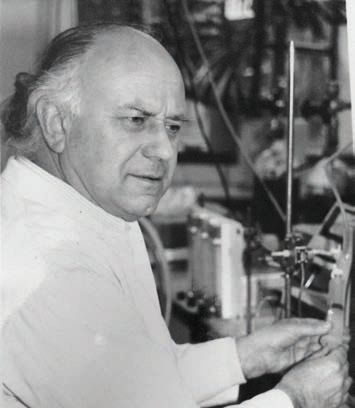
Physiology News Magazine
Obituary: Abraham Guz
1929 – 2014
Membership
Obituary: Abraham Guz
1929 – 2014
Membership
Lewis Adams
https://doi.org/10.36866/pn.96.45

Abe Guz, beloved husband of Nita, father of Deborah, Gabrielle and Stephanie and grandfather to their nine children, died on April 11, 2014 aged 84. Abe left Grocer’s Company School, Hackney in 1947 to study medicine at Charing Cross Medical School; he was a prize student at both institutions. We see the first evidence of Abe as a physiologist with a 1953 publication in BMJ on ‘Noradrenaline in Cardiac Infarction’ at the time of his first House appointment at Charing Cross Hospital. This was followed by national service as a medical officer in Germany where he achieved the rank of Acting Major.
On leaving the Army in 1955, Abe took a position at the Postgraduate Medical School/Hammersmith Hospital alongside contemporaries and renowned future respiratory physiologists John West and Moran Campbell. Abe gained a travel fellowship to Harvard (Beth Israel) Medical School and in a 1960 publication with his mentor Al Freedberg and George Kurland found support for the existence of ‘a vasodilator metabolite… of very short half-life’ explaining ‘the failure of others to detect such a substance in coronary venous blood’. This was a full 27 years before the identification of nitric oxide as the potent EDRF. In 1959 he transitioned to the newly formed Cardiovascular Research Institute in San Francisco under the mentorship of Julius Comroe. Here he established life-long friendships with the likes of John Widdicombe, Karl Wasserman, John Severinghaus and John and Hazel Coleridge, and began a productive research collaboration in cardiovascular physiology with Julien Hoffman, who he had first met at Hammersmith.
In 1961, Abe returned to the Charing Cross as Assistant Lecturer in the inaugural academic Department of Medicine headed by Hugh de Wardener. Together with Mark Noble and Di Trenchard, Abe continued his cardiovascular studies and thanks to Comroe’s influence, extended his research into the role of vagal pulmonary receptors on respiratory control and sensations. With help from John Widdicombe, plus a series of visiting scholars and practicing clinicians at the Charing Cross, Abe’s team published a series of definitive (and sometimes heroic) vagal blockade studies in conscious and anaesthetised humans and experimental animals to greatly refine our understanding of the significance of Hering–Breuer reflexes in respiratory rhythmogenesis.
I joined Abe’s group in 1977 and he turned my attention to the enigma of dyspnogenesis (as he called it), another Comroe influence. At the time, physiologists were trying to crack this nut using classical psychophysics to define the input/sensory characteristics of a range of quantifiable respiratory perceptions. Abe saw no reason why we shouldn’t measure dyspnoea directly using psychometrics, widespread in the assessment of clinical symptoms, notably pain; we settled on the Visual Analogue Scale following the lead of Edinburgh psychiatrist RCB Aitken. Psychometric assessment of dyspnoea is now widespread in Cardiorespiratory and Palliative Medicine and Abe’s contribution is justly commemorated by the ‘Abe Guz Lecture’ at the annual congress of the Association of Palliative Medicine.
Abe succeeded de Wardener as Head of Department of Medicine in 1982 and during his tenure (until 1994) it became one of the UK’s top research units for Cardiorespiratory Physiology and Medicine. The initiatives were numerous and varied but physiology continued to be his passion. His ability to identify the changing landscapes in research, led to the setting up of one of the UK’s first sleep labs and the identification of sleep-related upper airway muscle dysfunction in the pathophysiology of obstructive sleep apnoea. In the early 90’s he established successful collaborations with teams at the Hammersmith and Institute of Neurology, to utilise emerging brain imaging techniques in better defining the neural basis of human respiratory control and sensation.
On retirement, Abe became Emeritus Professor and continued to inspire and advise junior colleagues and students with his drive and encyclopaedic knowledge of medical research, well into the 2000s. His ability to ask the crucial question and then identify the person/group/technology that could help get the answer was extraordinary. His 300+ peer-reviewed publications are co-authored by hundreds of research collaborators across a wide range of specialities and thanks to him many have gone on to occupy senior positions in medicine and academia. Despite his prodigious work ethic and frequent 80 hour working weeks, Abe managed to find time to be both an accomplished violinist and scholar of Jewish history… although he never did quite get the hang of driving a motor vehicle. He will be greatly missed and fondly remembered.
